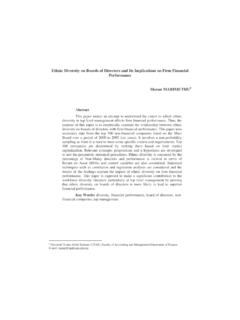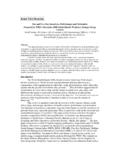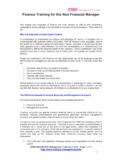Transcription of The impact of Non-Financial Incentives on …
1 IOSR Journal of Business and Management (IOSR-JBM) e-ISSN: 2278-487X, p-ISSN: 2319-7668. Volume 15, Issue 4 (Nov. - Dec. 2013), PP 37-46 37 | Page The impact of Non-Financial Incentives on employees motivation Muhammad Ijaz1, Azhar khan2 (supervisor) Executive Development Center, Gandhara University, Peshawar, Pakistan Abstract: The purpose of this study is to exhibit to what extent Non-Financial Incentives are utilized in the public sector of Pakistan; Agricultural Training Institute (ATI) and whether Non-Financial Incentives have the potential to increase the motivation of public employees as much as the financial Incentives . Incentive is any means that makes an employee desire to do better, try harder and expend more energy. Non-Financial Incentives such as participation in decision making, verbal or written recognition of good work etc.
2 Are the kinds of Incentives that do not involve direct payment of cash. To realize the objectives of the thesis, a survey study was administered at Agriculture Training Institute. According to the results of the study, most of the employees think that the level of utilization of the Non-Financial Incentives in their organization is inadequate. Also, the findings suggest that they value Non-Financial Incentives as much as financial Incentives . Thus, within the limitations of the survey study, it may be concluded that Non-Financial Incentives have the potential to increase the motivation of personnel in this public organization. Keywords: Non-Financial Incentives , Motivation, Recognition, Public Organizations. I. Introduction It is widely accepted by organizational experts manpower is of the most valuable asset of every organization because work is carried out through human beings.
3 The true success of an organization is dependent on employees. Organizational personnel can divert the direction of the organization from low profit to high profit and vice versa. The purpose of this study focuses on Non-Financial Incentives and their impact on employees motivation. It also focuses how much Non-Financial Incentives are applied/ practiced in public sector employees. As Non-Financial Incentives do not involve direct payment of cash to employees. It may be tangible or intangible. Some examples of Non-Financial Incentives includes; involvement of employees in decision making, recognition of employees on desirable performance , assigning tough but attainable assignments, appreciating work through small gifts like plagues, ticket to restaurant etc. purpose of the study The study will focus on the solution of problems and issues that are associated with the well administered compensation and its practices in public sector (Agriculture) Pakistan.
4 As we know that agriculture is the back bone of Pakistan s economy and most of the people either directly or indirectly dependent on agricultural products. Therefore it is vital to develop this sector according to the present needs. In order to develop this sector, all the employees in the agriculture sector must be motivated to use their skills properly. I will focus the employees of Agricultural Training Institute, district Peshawar, Khyber Pakhtoonkhwa. All the employees of Agricultural Training Institute, Peshawar, are categorized in grade system like the head of Agricultural Training Institute is Principal who is placed in grade 20, Vice Principal BPS 19, all the immediate officers are placed in grade 18, 17, and up to 1. Objectives of the study To find out the degree of utilization of the Non-Financial Incentives in this public organization, based on the perceptions of public employees?
5 To know which type of Non-Financial incentive do the public employees value most? To discover what type of incentive in this organization employee s value most? II. Literature Review Incentives , rewards and recognition The term Incentives , Rewards , and Recognition are used interrelated in the organization setting and there is no broader difference among them. However the main category is the Incentives . Incentives mean any source or medium that encourages an employee or group of employees to perform better and to exert more effort beyond expectations. Basically Incentives are divided into two main groups: financial Incentives and non The impact of Non-Financial Incentives on employees motivation 38 | Page financial Incentives . financial Incentives include direct payment of cash and while non financial Incentives may be in the form of promotion of employees, flexible time, autonomy and involvement in decision making etc.
6 Motivation Motivation is something that can lead to better performance when other conditions are met (Ivancevich, & Matteson 1988). The term motivation is derived from the word motive means any reason for taking action. The psychological processes that cause the arousal, direction and persistence of voluntary actions that are goal directed (Kreitner & Kinicki et A general definition for motivation can be given as the degree to which an individual want and chooses to engage in certain specified behavior. Motivation in the work place refers to, the degree to which an individual wants and tries hard to do work well at particular task or job (Mitchell, 1982). According to Abraham Maslow (1943), employees have five levels of needs that motivate them to accomplish most of the levels.)
7 Levels of needs are: physiological, safety, social, esteem and self-actualization. If the organization has well administered compensation strategy, employees will be motivated to satisfy their needs. The job related factors (work itself-challenging, opportunity for advancement) are the real motivators and others are just Hygiene factors that retain employees in the job (Herzberg, Mousner & Snyderman 1959). Job characteristics model pointed out that the jobs with non- financial Incentives have a high motivating power (Hackman & Oldham, 1980). Promotion Promotion can be used as motivational tool. It is a way of rewarding the employees meeting the organizational goals thus it serves as mean of synchronizing organizational goals with personal goals (Lazear & Rosen, 1981). Employee Recognition It is crystal clear that the main and repeated cause of turnover is the lack of employees recognition.
8 In particular, this lack of recognition has resulted in firms loosing disenchanted innovators as well as lower level of effort and even sabotage and espionage (Dutton,1998). Disturbingly, recognition is often perceived as a costly, non essential practice and generates no significant benefit to organization (McConnell,1997). Gines (1998) observes that companies must foster employee motivation through acknowledging achievements that are in line with corporate long term objectives as well as activities that generate immediate results. Feedback Feedback is basic source of educating human in the sense of removing barriers they face in propagating their activities towards the targets they are given in their working environment (Watts, 2007). Theoretical Framework Independent Variables Dependant Variable Theoretical framework Employee s Motivation Non financial Incentives Recognition of work Autonomy Feed Back Promotion & Career Participation in Decisions The impact of Non-Financial Incentives on employees motivation 39 | Page III.
9 Research Methodology Data Collection A questionnaire list has been used for the collection of data. The researcher had direct access to the Agricultural Training Institute for collecting the data. A copy of this questionnaire is included in appendix A. Study Population For the purpose of this study the employees of Agricultural Training Institute (ATI) were selected. The Agricultural Training Institute (ATI) has a total number of 100 employees. The main aim of this institute is to provide training to people/ students/ officers, who will be able to handle agricultural related problems in different areas of the province/ country. The list of questionnaire is distributed among all (100) employees. The researcher had fully access to all employees of Agricultural Training Institute (ATI), as being a resident of the same ATI colony.
10 So due to easy access most of the employees participated and completed the questionnaire list. Some of them also refused in participating the study. However the response rate was 80%. Demographic characteristics The demographic section of the questionnaire consists of age, gender, level of education, position level, number of years worked in organization, and the name of the department where an employee works. In the sample the number of male respondents are N= 75 ( ) while female respondents are N= 5 ( ). The majority of respondents are of age between 36 & 45. Majority of the employees (52%) are master degree holder. Most of the employees are having non managerial jobs. Most of the employees have worked for more than 10 years in the current organization. The department of employees according to the nature of their jobs, some do job in finance, human resource, training and development department.
















